Articles
- Page Path
- HOME > J Musculoskelet Trauma > Volume 23(4); 2010 > Article
-
Original Article
- Treatment of the Unstable Intertrochanteric Fracture with Proximal Femoral Nail Antirotation: Comparison with Compression Hip Screw with Trochanteric Stabilizing Plate
- Tae-Ho Kim, M.D., Jong-Oh Kim, M.D., Seung-Yup Lee, M.D., Geon-Ung Yun, M.D.
-
Journal of the Korean Fracture Society 2010;23(4):353-359.
DOI: https://doi.org/10.12671/jkfs.2010.23.4.353
Published online: October 31, 2010
Department of Orthopedic Surgery, Mokdong Hospital, Ewha Woman's University School of Medicine, Seoul, Korea.
*Department of Orthopedic Surgery, Sahmyook Medical Center, Seoul, Korea.
- Address reprint requests to: Jong-Oh Kim, M.D. Department of Orthopedic Surgery, Mok-dong Hospital, Ewha Woman's University School of Medicine, 911-1, Mok-dong, Yangcheon-gu, Seoul 158-710, Korea. Tel: 82-2-2650-5276, Fax: 82-2-2642-0349, ewhamdos@korea.com
• Received: April 21, 2010 • Accepted: August 11, 2010
Copyright © 2010 The Korean Fracture Society
- 780 Views
- 2 Download
- 6 Crossref
Figure & Data
REFERENCES
Citations
Citations to this article as recorded by 

- Results of Asian Type Gamma 3 Nail in Treatment of Trochanteric Fractures
Bing Zhe Huang, Yong Wook Park, Jin Su Park, Kyu Cheol Noh, Soung Yon Kim, Kook Jin Chung, Hong Kyun Kim, Hyong Nyun Kim, Yong Hyun Yoon, Ji Hyo Hwang
Journal of the Korean Fracture Society.2014; 27(3): 213. CrossRef - Comparative Study of Intertrochanteric Fracture Treated with the Proximal Femoral Nail Anti-Rotation and the Third Generation of Gamma Nail
Jae-Cheon Sim, Tae-Ho Kim, Ki-Do Hong, Sung-Sik Ha, Jong-Seong Lee
Journal of the Korean Fracture Society.2013; 26(1): 37. CrossRef - Comparative Study of Proximal Femoral Nail Antirotation and Zimmer Natural Nail for the Treatment of Stable Intertrochanteric Fractures
Jee-Hoon Kim, Oog-Jin Shon
Journal of the Korean Fracture Society.2013; 26(4): 305. CrossRef - A Comparison between Compression Hip Screw and Intramedullary Nail for the Treatment of AO/OTA A2.2 Intertrochanteric Femoral Fracture
Phil Hyun Chung, Suk Kang, Jong Pil Kim, Young Sung Kim, Ho Min Lee, Jong Hyun Kim
Journal of the Korean Fracture Society.2013; 26(1): 44. CrossRef - The Treatment of Intertrochanteric Femoral Fracture with Proximal Femoral Nail Antirotation
Jong Won Kim, Hyun Soo Park, Young Soo Jang, Jae Hyuk Choi, Sung Ju Bae, Chan Il Bae
Journal of the Korean Fracture Society.2012; 25(4): 257. CrossRef - Operative Treatment with Gamma 3 Nail in Femur Intertrochanteric Fracture
Ki-Do Hong, Jae-Chun Sim, Sung-Sik Ha, Tae-Ho Kim, Yoon-Ho Choi, Jong-Hyun Kim
Journal of the Korean Fracture Society.2011; 24(1): 7. CrossRef
Treatment of the Unstable Intertrochanteric Fracture with Proximal Femoral Nail Antirotation: Comparison with Compression Hip Screw with Trochanteric Stabilizing Plate
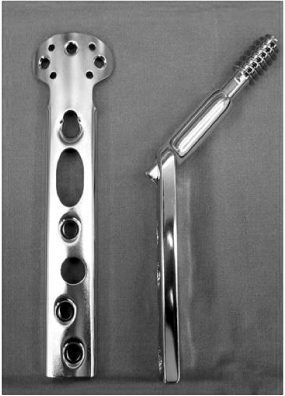
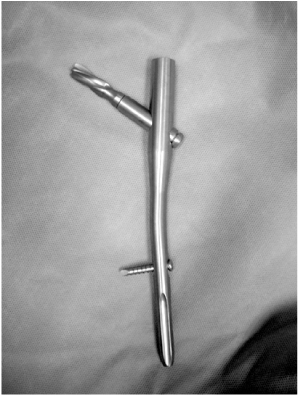
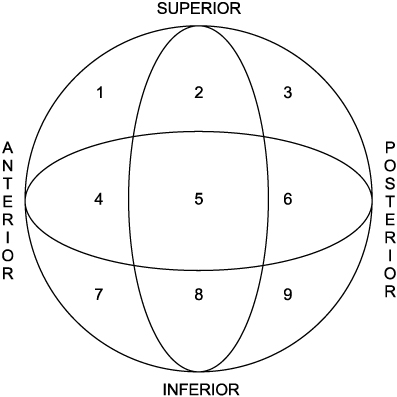
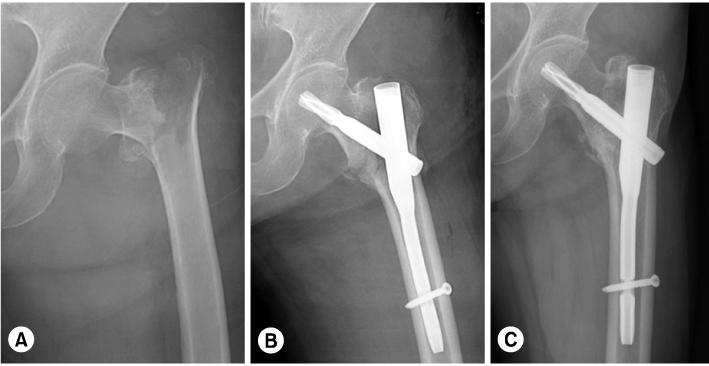
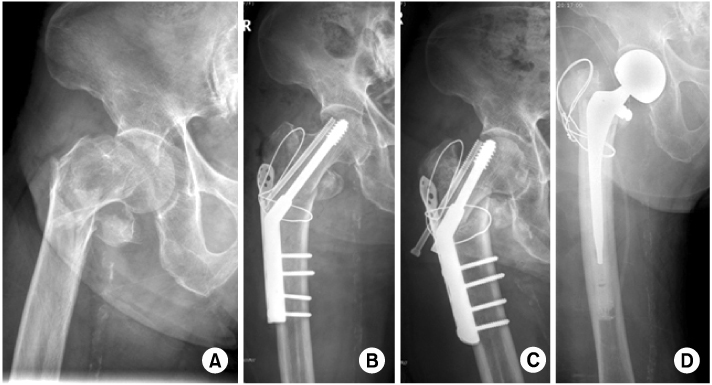
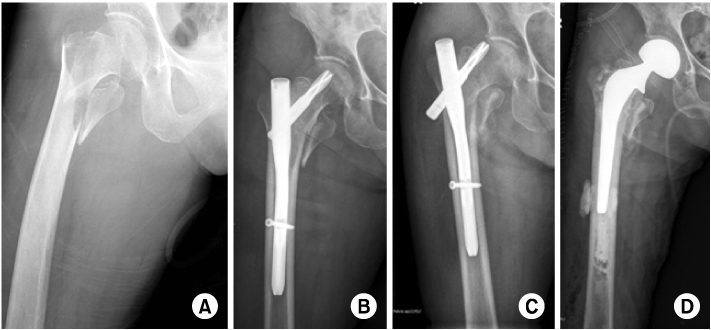
Fig. 1
Photographs of real implant of TSP (Trochanteric Stabilizing Plate).
Fig. 2
Photographs of real implant of PFNA (Proximal Femoral Nail Antirotation).
Fig. 3
Cleveland index.
Fig. 4
(A) 73 year old female patient presented with intertrochanteric fracture as AO/ASIF classification A2.2.
(B) Postoperative radiograph shows that good reduction and well positioned PFNA blade.
(C) Postoperative 6 mons radiograph shows minimal sliding of PFNA blade and well united fracture site.
Fig. 5
(A) 84 year old female patient presented with intertrochanteric fracture as AO/ASIF classification A2.2.
(B) Postoperative radiograph shows that acceptable reduction but superior positioned lag screw.
(C) Postoperative 8 weeks radiograph shows cutting out of the lag screw.
(D) Reoperation was done with cemented bipolar hemiarthroplasty.
Fig. 6
(A) 73 year old female patient presented with intertrochanteric fracture as AO/ASIF classification A2.2.
(B) Postoperative radiograph shows that poor varus reduction and superior positioned PFNA blade.
(C) Postoperative 4 weeks radiograph shows cutting out of the PFNA blade.
(D) Reoperation was done with cemented bipolar hemiarthroplasty.
Fig. 1
Fig. 2
Fig. 3
Fig. 4
Fig. 5
Fig. 6
Treatment of the Unstable Intertrochanteric Fracture with Proximal Femoral Nail Antirotation: Comparison with Compression Hip Screw with Trochanteric Stabilizing Plate
Demographic characteristics between the group 1 and 2
Comparison of radiographic results
*TAD: Tip apex distance.
Immediately postoperative reduction status
Comparison of clinical results
*EBL: Estimated blood loss.
Table 1
Demographic characteristics between the group 1 and 2
Table 2
Comparison of radiographic results
*TAD: Tip apex distance.
Table 3
Immediately postoperative reduction status
Table 4
Comparison of clinical results
*EBL: Estimated blood loss.

 E-submission
E-submission KOTA
KOTA TOTA
TOTA TOTS
TOTS






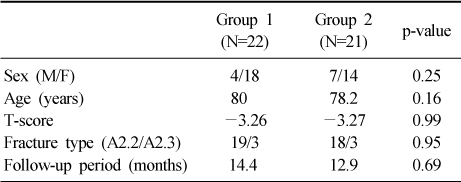
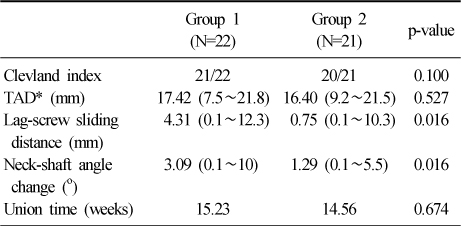

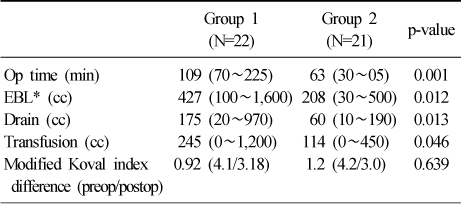
 Cite
Cite

